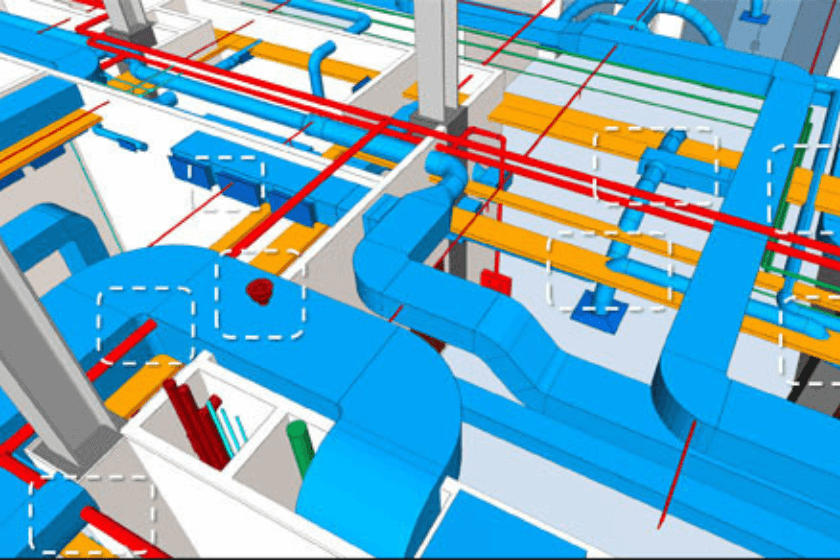
Construction projects have never been more complex. With multiple trades working simultaneously and tight deadlines to meet, coordination challenges can quickly derail even the most well-planned projects. That’s where 3D BIM coordination becomes your secret weapon.
Building Information Modeling (BIM) coordination is the process of integrating and managing digital models from different disciplines—architectural, structural, mechanical, electrical, and plumbing—to identify and resolve conflicts before construction begins. When done correctly, 3D BIM coordination services can reduce costly rework, minimize delays, and improve overall project quality.
This comprehensive guide will walk you through the essential steps to master 3D BIM coordination, providing you with the tools and strategies needed to streamline your next construction project.
What Makes 3D BIM Coordination Essential?
Before diving into the process, it’s crucial to understand why effective BIM coordination has become indispensable for modern construction projects. Traditional 2D drawings often leave room for interpretation, leading to on-site conflicts that could have been prevented during the design phase.
3D BIM coordination eliminates these issues by creating a virtual environment where all building systems can be visualized together. This approach allows teams to identify clashes between different trades, optimize space utilization, and ensure all components fit together seamlessly before breaking ground.
The benefits extend beyond clash detection. Effective coordination improves communication between stakeholders, reduces material waste, and can significantly decrease project timelines. For complex projects involving multiple contractors, proper BIM coordination often means the difference between success and costly delays.
Step 1: Establish a Clear Communication Plan
Success in 3D BIM coordination begins with establishing robust communication protocols among all project stakeholders. This foundational step sets the tone for the entire coordination process.
Start by defining roles and responsibilities for each team member. Who will be responsible for model updates? Which team handles clash detection? How will conflicts be communicated and resolved? These questions need clear answers before any modeling work begins.
Create a coordination schedule that outlines when models will be shared, reviewed, and updated. Weekly or bi-weekly coordination meetings are typically effective, depending on project complexity and phase. During these meetings, teams should discuss model updates, review clash reports, and plan resolution strategies.
Document your communication protocols in a project-specific BIM execution plan. This document should detail file naming conventions, model sharing procedures, and quality control standards. When everyone follows the same guidelines, coordination becomes more efficient and errors are minimized.
Step 2: Conduct Clash Detection
Clash detection forms the heart of 3D BIM coordination services. This process involves comparing models from different disciplines to identify physical conflicts between building components.
There are three primary types of clashes to monitor: hard clashes occur when two objects occupy the same space, soft clashes happen when objects violate predefined clearance requirements, and workflow clashes involve scheduling conflicts between different construction activities.
Run clash detection analysis regularly throughout the design phase. Many teams perform daily or weekly clash detection runs, depending on how actively models are being updated. Early detection allows for easier resolution when design changes are still manageable.
Prioritize clashes based on their impact and difficulty to resolve. Not all clashes are created equal—a major duct conflicting with a structural beam requires immediate attention, while minor clearance issues might be addressed in later coordination cycles.
Step 3: Resolve Clashes and Conflicts
Identifying clashes is only half the battle. The real value of 3D BIM coordination lies in efficiently resolving these conflicts through collaborative problem-solving.
When addressing clashes, involve all relevant disciplines in the resolution process. The mechanical engineer might suggest rerouting ductwork, while the structural engineer could recommend adjusting beam locations. Sometimes the optimal solution requires input from multiple trades working together.
Document all clash resolutions thoroughly. Keep track of what changes were made, who approved them, and when they were implemented. This documentation proves invaluable for future reference and helps prevent similar issues from recurring.
Consider the downstream effects of each resolution. Moving a pipe to avoid a structural conflict might create new clashes with electrical systems. Always verify that clash resolutions don’t create additional problems elsewhere in the model.
Step 4: Model Review and Approval
After resolving clashes, implement a systematic review and approval process to ensure all changes meet project requirements and quality standards.
Establish clear review criteria that address both technical accuracy and design intent. Models should be checked for dimensional accuracy, proper component relationships, and compliance with project specifications. Review processes should also verify that resolved clashes don’t compromise system performance or accessibility requirements.
Use collaborative review sessions where representatives from each discipline can examine the coordinated model together. These sessions often reveal issues that might be missed during individual reviews, such as maintainability concerns or installation sequence problems.
Implement version control procedures to track model revisions and ensure everyone works with the most current information. Clear version numbering and change logs help prevent confusion and miscommunication.
Step 5: Continuous Monitoring and Updates
3D BIM coordination is not a one-time activity but an ongoing process that continues throughout the project lifecycle. Regular monitoring and updates ensure coordination remains effective as designs evolve.
Schedule regular model updates based on design progression and construction phases. During schematic design, monthly updates might suffice, while construction documentation phases may require weekly or even daily updates.
Monitor key performance indicators to assess coordination effectiveness. Track metrics such as the number of clashes detected and resolved, time required for resolution, and the frequency of recurring issues. These metrics help identify areas for process improvement.
Maintain coordination momentum by celebrating successes and learning from challenges. When coordination prevents a major on-site conflict, share this success with the team. When issues arise, use them as learning opportunities to refine your coordination process.
Tools and Technologies for BIM Coordination
Successful 3D BIM coordination relies heavily on specialized software tools designed to handle complex model integration and clash detection. Popular options include Autodesk Navisworks, which excels at model aggregation and clash detection, Bentley Navigator for large infrastructure projects, and Trimble Connect for cloud-based collaboration.
Choose tools that integrate well with your existing design software and support your team’s workflow preferences. Some teams prefer desktop applications for detailed analysis, while others benefit from cloud-based platforms that facilitate remote collaboration.
Consider specialized tools for specific coordination tasks. Fabrication modeling software can provide more detailed clash detection for MEP systems, while 4D scheduling tools help identify workflow conflicts during construction sequencing.
Best Practices for Successful BIM Coordination
Effective communication remains the cornerstone of successful coordination. Establish regular touchpoints between all disciplines and maintain open channels for discussing coordination challenges. When conflicts arise, address them promptly rather than allowing them to compound.
Standardize your coordination processes across projects. Develop templates, checklists, and standard operating procedures that can be adapted for different project types. Consistency in approach leads to more predictable outcomes and reduced coordination time.
Invest in team training and development. BIM coordination tools and techniques continue to evolve, and keeping your team current with best practices pays dividends in improved efficiency and coordination quality.
Leveraging Professional 3D BIM Coordination Services
While internal coordination capabilities are valuable, many organizations benefit from partnering with specialized providers like Chudasama Outsourcing for comprehensive 3D BIM coordination services. Professional coordination services bring specialized expertise, advanced tools, and dedicated resources that can enhance project outcomes.
Professional services can be particularly valuable for complex projects, organizations building internal BIM capabilities, or teams facing tight project schedules. The key is finding providers who understand your project requirements and can integrate seamlessly with your existing workflows.
Maximizing Your BIM Coordination Success
Implementing effective 3D BIM coordination transforms how construction projects are planned and executed. By following these systematic steps—from establishing clear communication protocols to maintaining continuous monitoring—your team can prevent costly conflicts and deliver projects more efficiently.
Start with small, manageable projects to build coordination competency before tackling larger, more complex efforts. Focus on establishing robust processes and clear communication channels, as these foundational elements determine coordination success more than any specific software tool.
Remember that successful BIM coordination is ultimately about people working together effectively. While technology provides the tools, collaborative relationships between disciplines create the environment where coordination truly succeeds.


